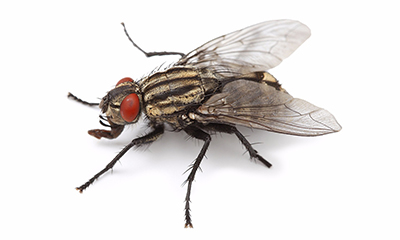
COMMERCIAL & DOMESTIC PEST CONTROL

When house flies are seen flying around it can be not only annoying, but also a significant risk in terms of transmitting diseases. Unfortunately, house fly control is not always straight forward, particularly as different types of fly should be dealt with in different ways.
The Common Housefly and the Lesser Housefly are the most widespread household flies. The adult is 7-8mm long, grey in colour with black stripes on the back, with a single pair of veined membraneous wings.
The large compound eyes take up most of the head and are wider apart in the female than the male of the species. The smaller Lesser Housefly, rejoicing in the scientific name Fannia canicularis, is the one that cruises around light fittings, abruptly changing direction in mid-flight.
The Housefly has a sticky pad on each of its six hairy feet, and these enable it to walk upside down on ceilings or crawl up windows.
Houseflies complete their life cycle of egg, maggot, pupa, adult in a week during warm weather. The eggs are laid in batches of about 120 on rotting organic matter and the legless white maggots burrow into this food until ready to pupate in loose soil or rubbish.
The answer to “where do flies go in the winter?” is that some hibernate, but most pass the winter in the pupal stage.
Houseflies may transmit a wide range of bacterial diseases.
When the place that the flies have been depositing their eggs has been identified the breeding site must be cleaned up thoroughly or removed. The elimination of the adult flies may then require fly bait, traps or the application of insecticide, but Shield Pest Control’s trained team will be able to advise on the best course of action.
